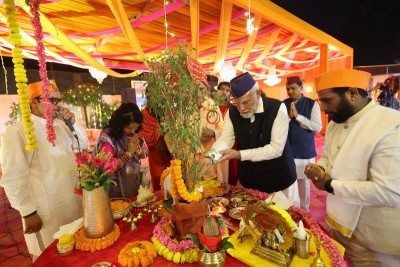 Guru Ram Das
Guru Ram Das
”He who calleth himself a Sikh of the true Guru, should rise early and meditate on God;
He should make an effort early in the morning, bathe in the inner tank of nectar;
Repeat God’s name under Guru’s instruction, and all his sins and transgressions shall be erased;
At sunrise he should sing the Guru’s hymns, and whether sitting or standing meditate on God’s name;
The disciple who at every breath meditateth on God, will be to the Guru;
The Gun imparteth instruction to that disciple to whom my Lord bestows His grace;
The servant Nanak prayeth for the dust of the feet of such a disciple of the Guru who himself. God’s name and Causeth others to do so.”
– (Gauri ka var – Mohalla 4, pg 305-06)
This hymn was composed by Guru Ram Das to instruct Sikhs about ways to practice their religion. Apart from this he also composed a hymn known as ‘Lawan’ in Suhi Mohalla 4, pg. 773 of Guru Granth Sahib to solemnize marriages. It embodies in itself a lesson for the couple to develop a true love for each other, which in reality refers to a human being developing a love for the divine. Guru Ram Das was a celebrated poet and composed about 638 ‘Shabads’ which account for roughly ten percent of hymns in the Guru Granth Sahib.
While Guru Amar Das introduced the Manji system, Ram Dasji extended it by adding to it the ‘Masand’ institution. Masands were Sikh community leaders who lived far from the Guru but collected revenue for Sikh activities and lead mutual interactions. These helped significantly in the propagation of Sikhism in subsequent decades.
Guru Ram Das was born as Bhai Jetha Mal Sodhi. He was orphaned at the age of 7 years and came to stay with his grandmother which led him to Guru Amar Das.
He served the Guru and sangat with utmost joy and dedication.
When the Mughals pressed charges against Guru Amar Das, Jetha went to court as his representative and eloquently defended his Guru and religious teachings, impressing the emperor so much that all charges were dismissed.
The third Guru was very impressed with Jetha’s service and admired the latter greatly. He was overjoyed when his youngest daughter, Bibi Bhani, decided to become Jetha’s wife.
Guru Amar Das declared him the fourth Guru and renamed him Ram Das, meaning the servant of God. He thus, became Guru at the age of 40 years, in 1574. He is credited with building the city of Amritsar, the holiest place for Sikhs.
As per history, the spot was chosen by his predecessor, and Ram Dasji founded the town calling it Ramdaspur or ‘Guru ka Chakk’. He invited traders and artisans to settle here and the town grew to become ‘Amritsar’ which means ‘the pool of nectar’. There is a ‘Sakhi’ attached to its discovery; it is said that Duni Chand Khatri was a rich landlord from the town of Patti, having five beautiful daughters. He was a egoistic man and once when he asked his daughters who provided them food and shelter, the four elder ones fed his ego by saying it was their father but the youngest daughter, Bibi Rajni replied, “It is God that provides for everyone“. Duni Chand was enraged and married her off to a leper as punishment. However, Bibi Rajni accepted him and served him with love. As she carried her ailing husband in a basket on her head looking for treatment for him, the duo reached a pool of water near Ramdaspur where she set him down under a ‘ber’ tree and went in search of food.
The leper sat there and observed that two crows came out white in color as they dipped in the pond. He realized that it was not an ordinary pool and decided to bathe in it to get rid of his disease. When he came out he was miraculously cured! Bibi Rajni came back and did not believe the occurrence till Guru Ram Das convinced her. The tree still stands in the Harminder Sahib premises, known as ‘Dukhbhanjani Beri’ (the tree that relieves pains and afflictions of people). The ‘sarovar’ was constructed at the miraculous pool of water and came to be called Amritsar. The foundation stone of Amritsar was thus laid on 13th June 1577. It was also the same spot that had been visited by Guru Nanak Devji on one of his “udhasis”.
According to another popular story, once Akbar visited Ramdaspur after having heard about ‘Guru Ram Das’s accolades, and offered a plate full of cold coins to Guruji as a mark of respect. The Guru immediately asked Arjan Dev, his youngest son sitting close to him, to take the coins and distribute them among the poor and needy. Akbar was amazed at this humility and wanted to gift him a ‘jagir’ of 12 villages for maintenance of Langar but again Ram Dasji refused saying, “Langar does not depend upon jagirs. Men fight with each other due to these jagirs. These are sources of evil passions, pride, and ego. We only believe in one God and by the name of God all creatures, continents, all worlds, and spheres are sustained. God is lord of this world and next.” Emperor Akbar was very pleased and declared that he had seen the embodiment of the living God in the Guru.
The city of Amritsar prospered und under the mentorship and divine blessings of the fourth Guru who recited Shabads and at langar with his Sikhs. In the evening he again attended the ‘darbar’ and addressed ‘sangats’ to teach them about Sikh ideology; to adopt a true way of living and believe in One God. On the pursuance of his cousins and other pilgrims, he decided to visit his birthplace in Lahore.
When the news of his arrival spread in Lahore, people flocked to the roads to welcome their ‘Sacha Padshah’ or True King as they called him. Guruji himself was overwhelmed and overjoyed at the love and devotion showered upon him. He stayed in his ancestral house in ‘Chuna Mandi’ for a few days and then converted it into a ‘Dharamsala’ and Gurudwara and also started langar in Lahore.
It is said that Sarai Mal, Guruji’s cousin, invited him to Lahore for his son’s wedding. Since Guru Ram Das could not go himself due to some reasons, he asked his oldest son, Prithvi Chand, to go in his stead but Prithvi refused, possibly due to dual motives; one, he was accused of accumulating wealth for himself from the offerings made to the Guru, so he probably thought his deceit would be brought to light if he left.
Secondly, as he felt that the time for succession was near, he did not want to leave Amritsar. Mahadev, Guru’s second son did not go as he was indifferent to worldly affairs. Arjan Dev, the youngest son, agreed to go and was instructed to stay back in Lahore after the wedding to manage the affairs of Sikh Sangat there.
However, after a few months, he started feeling homesick and wanting to be united with his father, wrote 3 letters to Guruji, two of which were intercepted by his eldest brother, Prithvi, when Guruji received the third letter, Arjan Dev was called back to Amritsar immediately and Prithvi’s ill-intentions were revealed.
Guru Ram Dasji embraced Arjan Dev and placed a coconut before him, descended the ‘gaddi’ himself, and seated the latter there in front of the assembly of Sikhs. Having nominated Arjan Devji as his successor in August 1581, Guru Ram Das left for his old headquarters at Goindwal and became ‘Jyoti Jot’ on September 1st, 1581.
(Image and Text credit: Khalsavox.com)
Support Our Journalism
We cannot do without you.. your contribution supports unbiased journalism
IBNS is not driven by any ism- not wokeism, not racism, not skewed secularism, not hyper right-wing or left liberal ideals, nor by any hardline religious beliefs or hyper nationalism. We want to serve you good old objective news, as they are. We do not judge or preach. We let people decide for themselves. We only try to present factual and well-sourced news.







